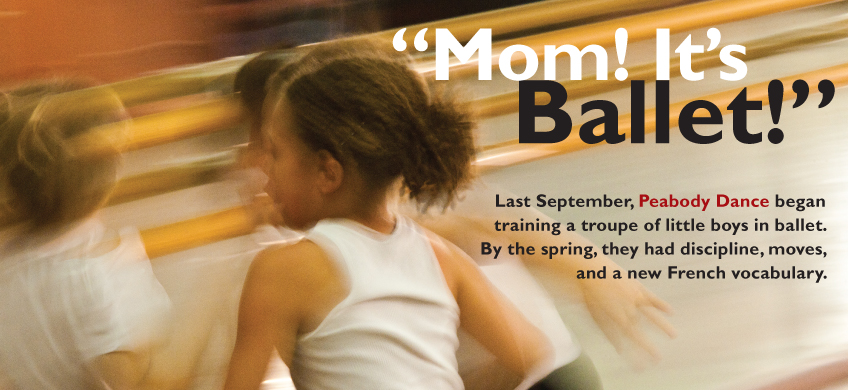
At 3:25 on a Monday afternoon last May, six young boys with numbers pinned to their shirts wait in the Patterson Park Public Charter School gymnasium. They look uncertain, stealing glances at each other and at Miss Carol and Miss Barbara, who seem to be in charge.
“Some of them are scared to come in,” says Miss Carol.
“Tell them we’re not going to bite,” says Miss Barbara.
A formidable woman who works for the school notes that 14 more boys signed up but have not shown up. She bustles out into the hallway, on the hunt for the no-shows. Miss Barbara observes a slender African American boy, No. 1, as he spontaneously spins round and round and round, unaware that he’s being watched. “He has a natural spot,” she says, meaning he turns his head faster than his body and returns his gaze to the same spot, maintaining his body’s alignment and avoiding dizziness.
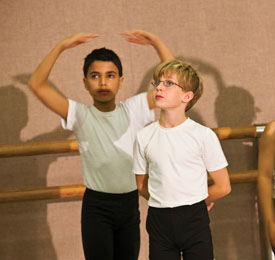
Noah Schwartz (left) and T.J. Langston watch intently in an April class. Eight months after first setting foot in the studio, they are preparing for their first performance.
Miss Barbara is Barbara Weisberger, the 84-year-old founder of the Pennsylvania Ballet in Philadelphia and artistic adviser to Peabody Dance in the Peabody Institute. She was George Balanchine’s first child dance student; when she was 8, she sat under a piano and watched the great choreographer create Serenade. Miss Carol, Carol Bartlett, is the artistic director of Peabody Dance. Dark haired and possessed of a British accent, she tells the boys—nine in number now that two more have wandered in and the school staffer has hauled in a third, who looks sheepish—to sit on the floor. The first thing a dancer does is stretch. Bartlett has them spread their legs, reach overhead with their hands, then bend and touch their toes. The boys have first names like Hassan, Alexander, Diago, Diallo, De’Eric, Dwayne, Glen, and Jeremiah. Most are 9 or 10 years old. They are here to audition for the Estelle Dennis/Peabody Dance Training Program for Boys. Those who show some flexibility and coordination and natural ability to move to music will be invited, along with boys selected today from two other auditions, to participate in 32 weekly ballet classes at Peabody, beginning in September. The classes will not be Saturday morning rec center stuff but serious dance instruction designed to start the long process of training male ballet dancers. The classes will be taught by professional dancers and choreographers, and will be tuition-free. All that will be required of the boys is that they show up every Saturday at 9 a.m. and work hard.
Bartlett and dance teacher Timothy Rinko-Gay lead the boys in unfamiliar moves with unfamiliar names: Plié. Relevé. Plié. Relevé. Jump! They get the jump part. After a while, Bartlett cues some Latin music on the portable sound system. A few of the boys are game but hopeless; whatever imbues a kid with the ability to sense the music’s pulse and move to it, they don’t have it. Others look like naturals. Bartlett and Weisberger keep an eye on No. 1, who clearly loves to move; No. 5, who seems to know some steps; No. 13, who follows every instruction intently; and No. 2, a sober little Salvadoran boy named Alexander Ortega, who does a robo-arms move and smiles for the first time. At some point, No. 6 slips out of the room, evidently deciding that ballet is not for him.
After about an hour, Miss Carol and Miss Barbara assemble the boys and explain what will happen next should they be chosen—the classes at Peabody, the attendance requirement, the opportunities. Weisberger tells them, “The greatest dancers in the world are men. Gene Kelly. Fred Astaire.” One boy asks if the classes will be only ballet. Yes, Weisberger says, because ballet is the foundation, “the ABCs of dance.” She tells them, “You don’t pay, but you have to work hard. You give back by working hard.”
The boys soberly take this in. One of them, Alexander, raises his hand. “Where is Peabody?” he asks.
ESTELLE OWEN DENNIS WAS born in the Roland Park neighborhood of Baltimore in 1909, and began dancing as a young girl. According to her obituary in The Baltimore Sun, as a teenager at a finishing school in New York City she lied about her age and joined the Metropolitan Opera corps de ballet. Her furious parents ordered her home and threatened to cut her off from the money they had set aside to pay for her society debut in Richmond, Virginia. She did go home, but only long enough to scoop up the money and race back to New York, where she used the funds to buy more dance lessons. She returned to Baltimore in 1934 and founded a company, Dance Theatre. She seemed to know everyone in professional dance, so a steady flow of world-renowned artists visited her dancers, including Balanchine, Alicia Markova, Margot Fonteyn, Alexandra Danilova, Martha Graham, and Ted Shawn.
When she died of a heart attack in 1996 at age 87, Dennis left the Estelle Dennis Trust Fund to provide scholarships for young “advanced male students” in Maryland who, buoyed by their instruction in Baltimore, would then pursue professional training in New York with the goal of joining a major professional company. But when the scholarship trust committee, which included Bartlett, began searching for advanced male dancers in Maryland, they didn’t find many. Bartlett finally proposed something new. “About two years ago, I said, ‘Look, if the [advanced] boys aren’t out there, can you allocate some funds for us to begin our own boys’ training program?’” The trust committee voted $8,000 for a pilot program that first held auditions in 2009.
Bartlett recalls those initial auditions, which attracted mostly African American boys ages 11 to 18. “We had a gymnasium full of boys and it was overwhelming. You’d expect maybe a little bit of resistance, of tentativeness, but the thing that struck me is they were so grateful, so engaged, and so joyful to be given this opportunity. They were just so gung-ho.” Weisberger remembers, too. “We were all moved beyond words. Carol and I had tears, we cried. We let them do their thing, and they were fantastic. They were natural movers and they loved it.”
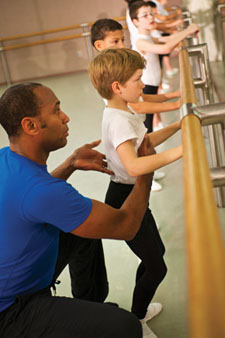
Thomas Langston's posture receives an adjustment from Meredith Rainey. Serious ballet training is an exacting process.
ON THIS FIRST SATURDAY MORNING of the fall semester, the corridor outside Peabody’s downtown dance studios is jammed with skinny little girls in pale blue leotards and yawning mothers and fathers wearing windbreakers and toting travel coffee mugs. In Room B22, a troupe of boys mill around, sizing up this unfamiliar situation—an expansive dance floor, a piano, a barre, a wall of mirrors. Bartlett comes in promptly at 9 o’clock, claps her hands, and sits them down in a circle so she can take attendance. There are fewer than expected. Devonte. Bill. Corey. Isaac. Aidan. Ameer. TJ. Thomas. Anthony. Weisberger is here as well, in black slacks and a turquoise blouse. The boys are a diverse crew: African American, Latino, white, Asian American. Some are part of prosperous families, some are not. A couple have already had a bit of dance instruction, but judging by the looks on their faces, most are not sure what they’ve gotten themselves into.
Bartlett first has the boys run for six counts, freeze for six counts, run for six, crouch for six, run for six. Trot in a circle. Freeze. Trot backwards. Freeze. Sit in a circle, legs outstretched and spread wide. Ameer is a gabby kid, and Bartlett shushes him. “Save your energy for your body.” Three more boys wander in. Noah. Elias. Sober little Alexander from the Patterson Park audition. One says, “My mom had a flat tire.” “We’re never in control, are we,” Bartlett replies. She brings them to the barre and instructs them in the proper way to plié, tells them to stand up straight, to never slouch against the barre or the wall. “When you do that, your muscles go all gooey,” she says. “Guys don’t want gooey muscles, they want tough muscles.”
After an hour, Bartlett invites the grown-ups into the studio and explains the program to them. A toddler on one mother’s lap sneezes, and instantly another mother’s arm shoots out with a tissue. Weisberger tells them, “I don’t even like to talk about learning to dance. We all dance. We love to dance.” She talks instead about the need for craft. “I love the word. C-r-a-f-t. Craft. We take whatever they love and match it with craft.” She says she cries at beauty. “I would be very happy if one day, one of these boys goes on the stage and makes me cry.” Then she tells them that she is 84 years old. Two of the moms exchange glances and one of the students, Corey, blurts out, “Jeez!”
The first-year boys and the adults stay to observe the second-year class. This group is older, and many of the boys are strikingly good. The grown-ups are rapt, but after an hour, most of the younger kids have found other ways to amuse themselves. There’s only so much ballet a 9- or 10-year-old can take. In the alcove that houses the rehearsal piano, there’s another barre, and a handsome kid named Devonte Tasker has his leg on the top rung, above shoulder height. Just because he can. Just because it makes him happy.
WATCH DEVONTE SIMPLY WALK down a hallway and you’ll see him dance. He can’t seem to help it. He’s a lithe African American kid with a sweet smile and a quiet nature. He lives in the Belair-Edison section of Baltimore with his mother, LaTanya Cherry, and has been dancing since he was 6 or 7 in a modern dance group at the New David Baptist Church of Christ. His mentor there, Ronald Malone, heard about the Peabody program and suggested that he give it a try. Cherry took him to the audition. “Oh, he was so excited!” she recalls. “But he didn’t know it was going to be ballet. He thought it was going to be modern dance.” After the first class in September, he came home and said, “Mom! It’s ballet! It was ballet, Mom! I hope I can do well, but I’m not sure.” She told him, “Calm down, calm down, just give it time.”
Cherry laughs easily in her small house on a Saturday afternoon. She apologizes for the clutter; she’s getting married in July and there’s “wedding stuff” all over. She’s gracious but looks tired. During the day she works for the Baltimore City Office of Home Energy; at night, she works a second job as a mail handler for the U.S. Postal Service. She says Devonte rides her about getting more exercise. “And he’s on me for eating healthy,” she says. “‘Let’s eat a lot of fruit.’ He’s very into eating fruit.”
What began for Devonte as one Peabody class per week has turned into three. He now attends a mixed class on Wednesday afternoons, boys and girls, and recently began a second Saturday class. Says his mother, “Devonte kind of sprang that last class on me. He said, ‘Mom! I can go to another class on Saturday afternoons!’ I said, ‘Ohhhh, what time, baby?’ He said 1 o’clock and I said, ‘That’s really cutting into my sleep time.’” But his grandmother agreed to take him; Cherry gets him there on Wednesdays, the one weeknight she doesn’t have to work.
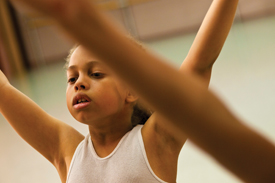
Anthony Johnson, age 10, concentrates on learning the choregraphy for A Midsummer Night's Dream. He practices at home with his 5-year-old sister.
On Saturday mornings in class, he is quiet and well behaved. “He’s going to pay attention because he really, really wants to master the dance, he really does,” Cherry says. “Whatever he does, he wants to do it well. If he doesn’t do well, he’s disappointed with himself. Sometimes I have to cheer him up.” His focus throughout a 90-minute class is not the rule among the other boys, at least not yet. From the start it was clear to Bartlett and the second Saturday morning teacher, dancer Meredith Rainey, that the class has problems with focus. A strong, lanky boy named Stephen has the natural grace and coordination of a born athlete but cannot resist clowning in the studio’s big mirrors, throwing punches and kung fu moves at his reflection when he’s supposed to be learning how to plié with a straight back and his butt tucked in. Ameer frequently interrupts with superfluous questions. TJ and Thomas are brothers, diminutive, good-looking kids who can’t seem to pay attention for longer than five minutes. Bartlett, who can be stern in class but tends to call the boys “sweetheart,” says, “It’s not their fault. It’s their homes, their schools, the culture.” Some of the boys have parents, some have guardians. Several are on medication for attention deficit problems. Some are tightly wound and cry a little or bang their heads when they fail to do a sequence properly.
By October, the boys have begun to pick up a new French vocabulary: chassé, plié, relevé, tendu. “What is ‘port de bras’?” Bartlett asks. Devonte answers, “Carriage of arms,” then demonstrates. Some are starting to look like dancers, at least now and then, and beginning to realize that the foundation of formal dance is the exacting practice of the same movements over and over again.
At the barre, one boy clowns with another. Bartlett spots him and waits, silent. He’s oblivious. She waits longer. Finally he notices her gaze and shuts up. “You took 16 seconds to get into focus,” she says. “I’ll not have you waste that kind of time in class.” A week later, Rainey conducts the class and the boys are so squirrelly he makes three of them take timeouts and leave the dance floor, a disciplinary practice that Bartlett frowns upon. At the end of class, eyes wide, Rainey says, “I am never having children.” Another morning, Bartlett is on a kid who keeps messing up at the barre. “You don’t learn it because you’re not paying attention.” “Sorry,” he says. She responds, “There’s no point in apologizing because this isn’t for me, it’s for you.” Later, however, when talking about the boys, Bartlett says, “What amazes me is how focused they are. It actually amazes me how long they can work at the barre.” How many of these kids have ever been in a situation where they’re asked to concentrate for 90 minutes on moving their bodies in strictly defined ways, over and over and over again? “I couldn’t ask for anything more than I’m getting.”
COME NOVEMBER, THE BOYS still stick their butts out when they plié, still forget to count when doing a sequence of steps, still have trouble keeping head, shoulders, and hips aligned. But they have an innate musicality, and they’re starting to grasp what real dance training is about. A few who had chronic problems with focus have been moved to more suitable classes, some to classes that include girls. Put boys in with girls, Bartlett says, and you’ll be amazed at how fast they start to behave.
They progress at different rates. The tallest boy in class, and at 12 the oldest, Isaac Bolton looks the most like a ballet dancer. His carriage is erect, he has good point and turn-out, and he learns new series of steps quickly. Bartlett likes his dark eyebrows and once playfully pretends to rub them off with her thumbs, making him grin. Bill Fan, a stocky Asian American kid who also studies violin at Peabody and sometimes shows up for dance with his violin case slung over his shoulder, struggles but keeps at it, and by mid-December, his determination begins to pay off. Peabody Dance hosts a Saturday morning open house and invites all the parents to watch a dancer named Kay Richards lead a special class for boys and girls in African dance. Richards has the kids stretch, plié in first position, and bounce on their feet to African drumming. She asks them to bend at the waist, backs flat, arms out to the side, and undulate their arms like wings. When she tells Bill he’s doing it perfectly, he looks up startled and says, “Me?” Later, when a series of steps brings him up close to his mother in the audience, he gives her a high-five.
In the middle of the class, one of the fathers, who is at least 30 pounds past a svelte dancer’s body, takes off his shoes and socks, rolls up his chinos, and joins the class. He’s a big guy but he can move. Before long, there are a half-dozen other parents gamely hopping about with the kids. It’s hard to say who’s having the most fun.
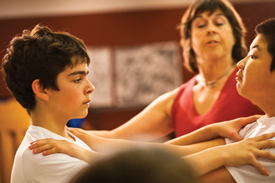
Carol Bartlett instructs Isaac Bolton (left) and Bill Fan. She later praises the entire class. "Good, boys! It always amazes me how musical you all are."
IN THE HALL BEFORE class one day, Isaac says to Devonte, “Can you do this?” Then he rolls on his back and like a contortionist tucks his heels behind his ears. Isaac came to dancing through community musical theater, which he first got involved with on the technical side, “operating lights and special effects and stuff,” he says. “It looked really cool and fun. But then I had to do some acting and really liked acting after that.” He has played Dodger in excerpts of Oliver!, Snoopy in You’re a Good Man, Charlie Brown, the wizard in Once Upon a Mattress, and a narrator “in the one where the guy tricks his friends into painting the fence for him” (The Adventures of Tom Sawyer). He was cast as the young Prince of York in the Baltimore Shakespeare Festival’s production of Richard III. He has a large collection of hats, likes film noir and Pokémon, and, his mother, Elizabeth, reports, “He likes to talk about yucky, gross body things like a 12-year-old boy should.”
Elizabeth is a rabbi at Congregation Beit Tikvah in Baltimore, but before taking up rabbinical studies she was a professional mezzo-soprano in Montreal. Her 17-year-old daughter, Doriya, also studied ballet at Peabody and is keenly interested in musical theater. After her own career in performing arts, Elizabeth observes her kids with mixed emotions. “I watch with bated breath and delight, and hopefulness that wherever they take their interests in the arts, I know with 100 percent certainty, it will feed them for their whole lives. I can’t tell them not to go for it, because I did it. But I know how hard it is, and how potentially heartbreaking.” She’s not surprised to hear how Isaac concentrates, and sounds like Devonte’s mom when she talks about him. “He really wants to do well, and it can be difficult for him when he’s critiqued. He’s a perfectionist and just wants to get it right. He is so hard on himself. Very self-critical.” But he likes to show her ballet positions in the kitchen, and sometimes when he’s frustrated about something he’ll chill himself out with a little yoga. His mother smiles and says, “He’s really something.”
THE DAY BEFORE St. Patrick’s Day, Wednesday afternoon, 4:30. Tim Rinko-Gay teaches a mixed class, 13 girls and, in a cluster along one section of the barre, five boys from the Saturday morning posse. More than half of the first-year boys have taken on one or two additional classes a week.
This is a demanding class. Ballet requires constant attention to posture, a lengthened spine, an elongated neck, a foot curled and pointed just so, shoulders and arms and hands in proper attitude. Rinko-Gay has them at the barre in fifth position. “Shoulders down, Beatrice. Back knee, Tabitha. Stand tall, pull up your ears. Push your toes down. No elf toes! Push them down like I’m standing on them. Stiff knees, Anthony, pull your hips up!”
Rinko-Gay is both strict and playful. He has the kids stand on one foot, one leg bent and off the floor, and jump. They try several times. It’s hard, and Rinko-Gay stops them and says, “Don’t get goofy, please. What was that? That was a chicken jump!” He makes a clownish leap, arms flopping all over the place. The kids and their parents, who are observing today, laugh. Working with one little girl at the barre, he tries to correct her stance. With one hand he squares her hip, with the other hand he aligns her foot, and lacking the third hand needed to straighten her posture, he bows his head and uses the top of it to push in her bottom, making the parents all laugh again.
At the far end of the room, Anthony Johnson works soberly. His mom says he calls this his “scary class.” Heather Johnson is a freelance writer and photographer and a single mother. She grew up in Sacramento, where she danced for 10 years, mostly jazz, tap, and musical theater. She started taking classes when she was two years younger than Anthony, and at times took up to a dozen a week. She is surprised to find herself shuttling her son to Peabody. “I’d always had the idea for my daughter, Tally, who has been dancing since she was 2,” she says. But every December she takes the kids to see The Nutcracker, and about 18 months ago Anthony asked her about taking a ballet class himself. “I have to admit that at the time I sort of steered him away from that by suggesting break dancing instead. There’s that stereotype of boys in ballet and I didn’t want him teased at school.” But when Anthony learned that a friend of his was auditioning for ballet at Peabody, he asked to do it, too. “He’s not the one with the stereotype in his head,” his mother says. “That’s me.”
At home, the kids practice, with Mom sometimes correcting a move or posture. “Tally points her toes and he tells her what to do,” Heather says. “They’ve got this whole thing going on. It’s quite interesting. One thing I think he’s looking forward to is when he gets to partner with a girl. I think he has it in his head that there’s going to be this little girl in a tutu and he’s going to be able to lift her up. I try to tell him that he doesn’t have that kind of strength yet.”
Heather is ambitious for her children. She takes Anthony to ballet on Wednesdays and Saturdays, break dancing on Tuesdays, and next year hopes to involve him in a couple of musical theater productions as well as two or three weekly dance classes. She laughs when she talks about how the parents usually are not allowed into the studio on Saturday mornings. “I want to know what’s going on in there, and it’s killing me. Because of my background, I want to go in there and take his foot and turn it out, and take his arms and place them in the right position. Maybe it’s a good thing I can’t watch.”
FOR SEVERAL WEEKS IN January and February, Bartlett had problems with a painful back. But today it’s much better and she’s in a bright mood. At the barre, she’s drilling 10 boys on proper movement of the arms from one position to another. She attends to a boy named Dakota. “Strong!” she says. “Strong! Feel your biceps!” She takes his scrawny arms and makes him smack the top of his head with his own hand. He giggles and so does she. They work through a variety of sequences and positions. Isaac displays perfect turn-out, and he’s not the only one having a good day. Bartlett says, “Yes, Bill! Look at your beautiful feet!” The boys get down on the floor for a new routine called roly-poly. They roll onto one side, straighten their bodies, pull their legs back into a curl, then roll over onto the other side. They like this and laugh as they roll around the floor. Bartlett smiles.
Peabody’s year ends every May with two performances by its dance students. This year the school will stage Bartlett’s choreography of A Midsummer Night’s Dream. There will be 170 students dancing in the production, and at the end of the first Saturday morning class in March, Bartlett gathers the boys around and announces that they will be elves. Bartlett cues up Mendelssohn’s score on the sound system and explains that their job on stage will be to escort Oberon, king of the forest. They look excited by this.
She shows them a sequence of wood-elf steps, and runs them through it once, then again. They pick it up fast and practice, a bit ragged but enthusiastic. Bartlett smiles broadly, turns to Mark Williams, the rehearsal pianist, and says, “How about that! And it’s only March!”
A month later, she has taught them more steps, and in mid-April they’re doing well with it. Bartlett says, “Good, boys! It always amazes me how musical you all are. It’s difficult music.” Today is one of the days when parents are in to watch, and despite that and the presence of a photographer and bright photo lights, the boys stay focused. Aidan Mellin, who in previous weeks often tried to slip unnoticed into a corner of the studio and sometimes has not looked much like a little boy enjoying himself, has come to life; learning a part for a real show seems to have energized him.
When Rainey, who teaches the first half of today’s class, spots Anthony standing at the barre yawning, he says, “Long day?” Rainey commutes to Peabody on a very early train from Philadelphia, and now he puts his hands on Anthony’s shoulders. “I feel you. I feel you. I had to get up at 5:30 to get here.” When Rainey walks away, Anthony yawns again, and the contagion spreads. Aidan yawns. Isaac yawns, a big one.
At the barre, the boys now know the routines, and remind Rainey of what they need to practice.
“What do we do now?” he asks.
“Dégagé,” says Alex.
“Dégagé? Good man.”
Eight months ago they were a gang of undisciplined, squirrelly little boys. Today they’re a ballet class. All in a line, in their black tights and white shirts and white shoes, they dégagé.
Dale Keiger, A&S ’11 (MLA), is associate editor of Johns Hopkins Magazine.
